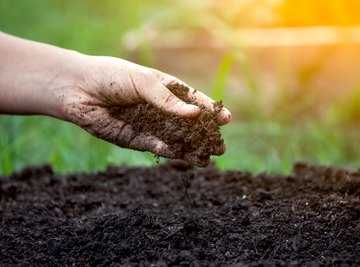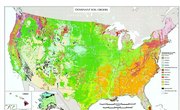
Science classifies soil into 12 orders, based on the region they’re from, the plants that grow in them and the climate variables that affect them. But for most backyard gardens in North America, soil falls into six main classifications, which are suborders of the 12 categories.
TL;DR (Too Long; Didn't Read)
The twelve soil orders include Gelisols, Histosols, Spodosols, Andisols, Oxisols, Vertisols, Aridsols, Ultisols, Mollisols, Alfisols, Inceptisols and Entisols, each with its own characteristics and uses.
The Twelve Scientific Soil Orders
The twelve soil orders begin with Gelisols soils that populate the frozen regions of the world and contain permafrost with 2 mm of the surface. In their frozen state, this soil type is sensitive to human activities and has no practical applications. Histosols, used for fuel and horticultural products, are full of organic materials and typically referred to as peat and muck. Spodosols soils support coniferous forests with cool, moist climates.
Andisols form in volcanic ash or debris from a volcano. Properties include the ability to retain water and remove large amounts of phosphorus to keep them from plants. Oxisols represent highly weathered soils rich in iron and aluminum oxides. When amended with lime and fertilizers, plants can thrive in them. Vertisols, soils rich with clay, swell with moisture and shrink when dry. Potters use clay soils to form earthenware, porcelain and other kitchenware, and when amended and irrigated properly, some plants thrive in them.
Aridsols represent the dry desert soils that often contain the skeletons of sea creatures, silica, salts, gypsum and more. These soil types work best for wildlife, ranges and desert recreational activities. Unless irrigated and amended, they don’t work for agricultural purposes. Ultisols are acid forest soils found in tropical and humid temperate areas of the world. Add amendments like lime and fertilizer to make them productive. Mollisols cover prairie and valley areas and represent some of the most productive agricultural soils in the world across the Great Plains and in the Central Valley of California, for example.
Alfisols highly support native plants and account for about 13.9 percent of the land in the U.S. In favorable climates, this soil type and its suborders favor farming, crop development and silvicultural use. Inceptisols, found on steep slopes and in many mountainous areas work best for watershed areas, recreation and forestry. Entisols categorize the soils that do not fit into the other 11 orders. Found in rocky and steep settings, these soil types are also found in shore deposits and large river valleys. The soils in deltas and river valleys provide habitats and crops around the world.
Soils in the Yard or Garden
Clay soils lack drainage because of their wet, sticky nature. They do have good, natural nutrients, but gardeners must amend this soil if they want to grow vegetables. This means they add other nutrients to make it less dense.
Sandy soil is good for growing vegetables because it has good drainage and it warms up well. Unlike clay soil, it doesn’t hold its nutrients, so gardeners must add additional components throughout the season. You can add compost, manure or grass clippings as a start. This can improve your sandy soil.
Peaty soil is good for plants that like acidic soil like blueberries. This tends to be a darker, heavier and damp soil without a ton of nutrients. Peaty soil is common in bog or marsh areas.
Silty soil typically contains a lot of nutrients because it comes from river sediments. This is a good and common soil for gardening. Lots of different types of plants do well in silty soil. The only precaution is that you might have to work on drainage to achieve the best results.
Chalky soil has a chunky, powdery texture and is found in rock or limestone areas. Small rocks can help with drainage, but this soil requires amendments and nutrients for lawns or gardens.
If you have loamy soil, then consider yourself lucky. Loamy soil is usually a mix of other soils, including sand, silt and clay. It has good nutrients and drainage, making for lovely plant conditions.
Test the Soil
When you are not sure of your soil type, most state or local Extension offices offer free soil tests from a sample of your soil You can also buy a simple soil test online to do it yourself.
Once you determine the soil type in your yard, look for plants specifically good for that type. If you want to modify or improve your soil, consult with a local garden enter or your Extension office. They can help you figure out the best plan, and you’ll be well on your way to a better garden.
References
About the Author
Stacy is the author of more than 15 books about gardening, animals, and nature. She runs the website DestinationNature.com to encourage kids and families to get outside.
